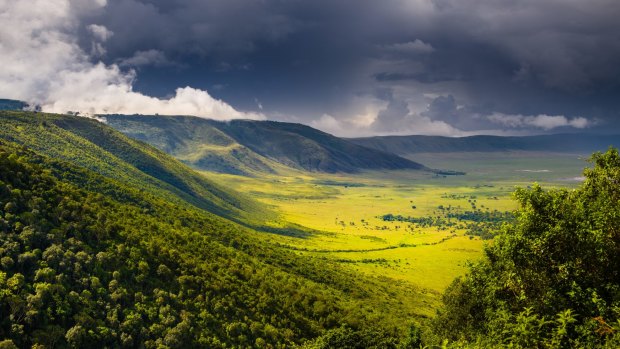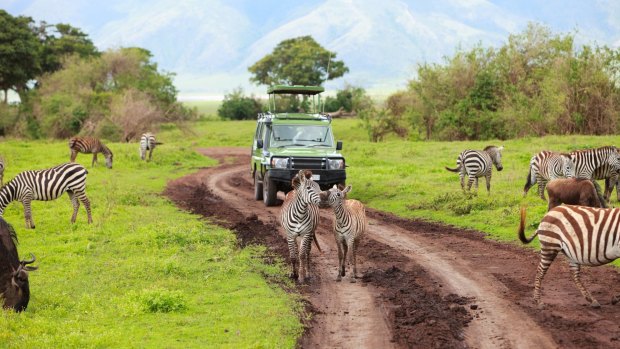This was published 4 years ago
Tanzania: The Ngorongoro Crater is a haven for wildlife
By Garry Maddox

A Forest in the Ngorongoro Crater.Credit: Shutterstock
It is a day for close encounters with lions. And it starts in the dark, heading for a dawn safari, when a handsome lioness swaggers along the road just 200 metres from our lodge on the rim of the Ngorongoro Crater in Tanzania. Arriving at the crater floor shortly afterwards, a young lion sits peacefully in the mist, untroubled by the curious humans watching from a safari vehicle just metres away.
Later, a pride of eight dozing lions have vehicles racing for kilometres to see them, when word spreads on safari radio. Eventually there are 23 cars and trucks full of tourists watching intently as the pride stretch and lazily wander around to find new places to sleep in the sun. One lioness tucks herself against the back of a car like a house cat on a lounge.
Then comes the most magnificent sight of all. Four male lions muscle their way confidently across the landscape, like a safari street gang. They take their time as they cover half a kilometre on their way to a lake as every eye in the vicinity watches with awe (the humans) and wary respect (other animals).

There's never any shortage of wildlife on a game drive around Ngorongoro Crater in Tanzania.Credit: Shutterstock.com
Ngorongoro Crater is that kind of place: an oasis for wildlife in Tanzania. A 600-metre-deep crater in an extinct volcano is a haven for an estimated 25,000 large animals including 6000 wildebeest, about 70 of these lions and fewer than 20 surviving black rhinos as well as an extraordinary variety of birds and wildflowers.
After flying from Arusha to Lake Manyara airstrip, it's a 90-minute drive to a lodge that is as striking as the wildlife. The fabulously quirky andBeyond Ngorongoro Crater Lodge is like an African village crossed with a Disney castle. A palatial suite has a vast bed, enough space for two leather armchairs and a bar around a fireplace – handy in the chill of the evening – and a freestanding bath beneath a banana leaf ceiling with a spectacular view from large windows to the crater below.
The friendly service and the food in the domed dining room, modern dishes using traditional Tanzanian produce, are designed to make guests feel comfortable and, frankly, spoiled. Even heading back to the room after dinner, there is another wildlife sighting. Two cape buffalo square off like wrestlers about to grapple on the lawn outside the dining room. Armed Masai guides warn me to stay exactly where I am while they chase them off.
When the two hyped up buffalo do leave, a dozen more arrive from the darkness like ghosts to follow them across the lawn. Only when it's clear do two Masai – one at front, one at rear – walk me to my room.
Next day's safari includes a lavish breakfast whipped up by our guide by a hippo pool in the warm sun. Later in the day, I join a German honeymoon couple in hiring another Masai as a guide for a walk along the top of the crater the next day. He arrives dressed in camouflage with a submachine gun, which is happily not required. We encounter a giraffe just 10 metres away on the trail and a herd of elephants a hundred metres below the path.
If it's elephants that really interest you – and there is a lot about them to be interested in – nearby Lake Manyara National Park is an eye-opener. A long-time ban on ivory poaching means numbers have been increasing in one of Tanzania's smaller wildlife reserves at just 325 square kilometres.
A very different but just as luxurious hotel, andBeyond's Lake Manyara Tree Lodge, is reached with a 3½-hour game drive from the same airstrip through the changing landscape of the park, including acacia savanna, evergreen forest, river crossings, floodplain grasses around the lake and rocky slopes on the Rift Valley escarpment.
There are regular glimpses of many of the more than 400 species of birds in the park but sadly no sign of the flamingo that flock in numbers vast enough to create a pink haze on the lake from a distance. While they move around the alkaline lakes of the Rift Valley, Lake Manayra is reputedly the best place in Tanzania to see them.
The park became widely known from the research into elephants by zoologist Iain Douglas-Hamilton in the 1960s and his later novel Among The Elephants, co-written with wife Oria. Founder of the non-government organisation Save The Elephants, his uncovering of what's called "the ivory holocaust" led to the poaching ban in 1989.
There are reputedly more than 300 elephants in the national park now – migrating out then coming back in as they please – which certainly seems credible when we come across a huge herd during a game drive on our second day. The first sign is just a single elephant crossing the road in front of the safari vehicle Then as we wait, more and more pass ... males, females and infants being ushered across.
Our guide says there is a herd that runs to more than 100 elephants currently and I count more than 70 around a clearing. And it seems to be an intelligent gathering with elephants, as he describes, communicating with each other by raising a foot and making sure the young are protected at all times, all led by a matriarch. As another sighting halfway up the escarpment later shows, elephants are also surprisingly good climbers. "Many roads going up the hills started with the elephants," our guide says. "When humans came along, they followed the trails."
Arriving at the lodge for the first time, there is a warm traditional welcome sung by staff in Swahili. Walking through a forest in the compound to a chorus of velvet monkeys, I come across 10 wooden huts on stilts that all seem impossibly secluded. All you can see is forest; all you can hear is a soundscape of close to distant animal noises.
Inside my hut is a huge bed inside mosquito netting, a writing desk, a bathroom with a freestanding bath and screens rather than glass windows. In keeping with the seclusion, there is no TV or music system and, instead of a minibar, there is a canvas bag on a hook full of ice and drinks. A deck, with branches for a balustrade, leads to an outdoor shower in a bamboo enclosure that looks out to the forested escarpment. It's a rare treat to shower outdoors in complete seclusion.
Guests are warned that the lodge is not fenced off so they should watch for elephants and, under no circumstances, walk around at night. If you dial reception, a Masai warrior armed with a rifle or bow and arrow, will turn up to escort you to where you want to go.
"Lion, leopard, elephant and buffalo are found in Lake Manyara National Park," the warning goes. "There is no physical impediment to them entering the area around the lodge."
Meal times are relaxed and "whatever, whenever, wherever" is the resort's motto. This service includes private meals and picnic packs. You can eat in the lodge's restaurant and bar area up a flight of stairs, or in the boma, a traditional open area surrounded by a fence, below. You have to watch the monkeys though. Less than an hour after I arrive and sit down to a bowl of soup for lunch, a monkey swoops across from a tree, grabs a chunk of bread and darts off.
Next morning, I'm woken by staff member Abdullah singing beautifully in Swahili as he brings coffee and cookies. When I get back from breakfast later, I find more monkey trouble. There are two in my room who have sneakily opened the unlatched screen door to eat the cookies on the coffee tray. Another striking sight in the park is the sheer number of baboons. Out on a game drive, we come across a troop of more than 300 on the road, lying down, sitting, grooming each other, squabbling and clambering up trees.
The chance to visit a local village called Mayoka proves to be well worth it. A community of 2000 people herd cattle, fish and grow corn and sunflowers. I watch them play a traditional board game called bao that uses seeds, visit a school and get to briefly have a kick around with the kids on a soccer field. No lions, no elephants, just the equally great sight of village children having fun.
TRIP NOTES
Garry Maddox travelled as a guest of Travel Associates.
Emirates flies daily to Nairobi and Dar es Salaam via Dubai. AirKenya and Air Auric fly to Lake Manyara. See emirates.com; airkenya.com; auricair.com
STAY
andBeyond Ngorongoro Crater Lodge has 30 suites overlooking the crater from $US1115 to $US1775 a person a night including meals, local drinks, game drives and a private butler. It is a 90-minute drive from Lake Manyara airstrip. andBeyond Lake Manyara Tree Lodge has elevated luxury log cabins from $US840 to $US1340 a person a night including meals, local drinks and game drives. It is a 3½-hour game drive from Lake Manyara airstrip to the lodge. See andbeyond.com
Sign up for the Traveller Deals newsletter
Get exclusive travel deals delivered straight to your inbox. Sign up now.